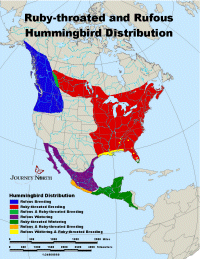| Please
Report Your Sightings! |
Fewer hummers at your feeder these days? Are these travelers really gone, or is something else at work? What do you think? Read what 3 experts think. Watch this season's hummingbird migration maps in action. What big ideas can you learn from them? Our expert shares his thoughts about the little migrants that reach the northern-most part of the breeding grounds. A BIG thank you for helping track hummers this spring!
Today's Report Includes:
- Highlights and Maps
- Animations: Snapshots of the 2010 Spring Migration
- A Special Thanks to Our Hummer Helpers!
- Year-end Evaluation: Please Share Your Thoughts
 Distribution Map |
||
| Rufous
|
Ruby-throated
|
Highlights:
The
migration is winding up and most hummingbirds are on their breeding grounds.
Observers continue to be thrilled and amazed when they come across these
remarkable migrants. From Carrington, North Dakota, along the outer
edge of the summer range comes an excited report, "First hummer came
to my feeder this afternoon. We are on the edge of there migration here.
I almost gave up on seeing any this year."
Fewer
Hummers at Montana Feeders This Year
From Kalispell, "There are fewer hummingbird at the feeders. In previous
years we changed the sugar water twice a week at least, and the birds
were everywhere. Can anyone explain this?"
Lanny Chambers has been seeing the same pattern in Missouri. "I don't understand this either," he said. Be sure to document your hummingbird sightings throughout the season. This is the best way to determine ups and downs of population each year.
Where
Are They Going? "Where oh where have they been?" asks one hummingbird lover. Are these travelers really gone, or is something else at work? What do you think? Once you've shared some ideas— |
 |
Speaking of experts, last week we asked your thoughts on the migration timing of hummers that breed far north. Here's what some researchers believe: The farther north a rubythroat breeds, the later it travels in the spring. Why? Most feathered travelers are adapted to arrive on their annual breeding grounds when food sources are available. The hummers that breed up north also tend to be the first to go south as fall approaches. So stay alert in the next four or five months as these travelers head for their wintering grounds. Also look for signs that the hummingbirds in your neighborhood are preparing for another incredible journey. This slideshow will remind you what to watch for. |
|
 |
 |
Ruby-throated
Hummingbird Migration Spring 2010 |
Rufous
Hummingbird Migration Spring 2010 |
- What week
showed greatest numbers of hummer sightings reported? Was there one
or two weeks when the leading edge pushed far into new territory? When
did that happen?
- Choose one species. Describe how the migration moved forward week-by-week after the hummingbirds entered the United States. (You can draw arrows on a blank map to show this.)
We'd
like to say a special thanks to Lanny
Chambers for contributing loads of data on rubythroat sightings and
for answering your hummingbird questions.
We
are also grateful to all the photographers
who generously allowed Journey North to post images of hummingbirds and
their amazing antics!
And
finally, thanks to all of YOU for keeping your eyes open,
feeders full, and reports prompt. We couldn't track these species without
your help! We look forward to seeing you again to track the fall migration!
Will you take a few minutes to complete our Year-end Evaluation? With your help, we can we document Journey North's reach, impact and value. We need comments like yours to keep the program going and growing.
-
Year-end Evaluation: Please Share Your Thoughts

This
is the FINAL Hummingbird Migration Update for Spring, 2010.
Please Join Us to Track the Fall Migration!





